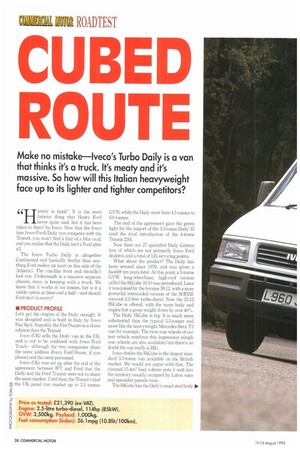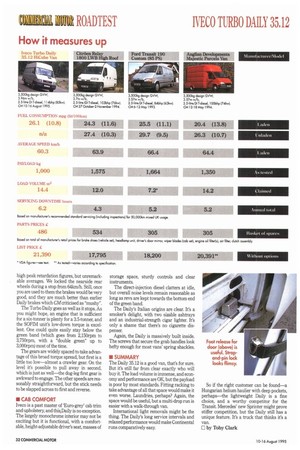CUBE D
Page 30

Page 32

Page 34

If you've noticed an error in this article please click here to report it so we can fix it.
ROUT
Make no mistake—Iveco's Turbo Daily is a van that thinks it's a truck. It's meaty and it's massive. So how will this Italian heavyweight face up to its lighter and tighter competitors?
4 4 istory is bunk". It is the most famous thing that Henry Ford never quite said, but it has been taken to heart by Iveco. Now that the Iveco (née Iveco Ford) Daily van competes with the Transit, you won't find a hint of a blue oval, and you realise that the Daily isn't a Ford after all.
The Iveco Turbo Daily is altogether Continental and basically beefier than anything Ford makes (at least on this side of the Atlantic). The van-like front end shouldn't fool you. Underneath is a massive separate chassis, more in keeping with a truck. We know that it works at six tonnes, but is it a viable option at three and a half—and should Ford start to worry?
• PRODUCT PROFILE Let's get the origins of the Daily straight. It was designed and is built in Italy by Iveco Fiat SpA. Arguably the Fiat Ducato is a closer relation than the Transit.
Iveco (UK) sells the Daily van in the UK, and is not to be confused with Iveco Ford Truck—although the two companies share the same address threw Ford House. if you please) and the same personnel.
Iveco (UK) was set up after the end of the agreement between IFT and Ford that the Daily and the Ford Transit were not to share the same market. Until then, the Transit ruled the UK panel van market up to 3.5 tonnes GVW, while the Daily went from 4.5 tonnes to 6.0 tonnes.
The end of the agreement gave the green light for the import of the 3.5-tonne Daily 35 (and the rival introduction of the 4-tonne Transit 230).
Now there are 27 specialist Daily Centres (ten of which are not primarily Iveco Ford dealers), and a total of 125 servicing points.
What about the product? The Daily has been around since 1979, and was given a facelift ten years later. At this point, a 5-tonne GVW, long-wheelbase, high-roof version called the HiCube 49.10 was introduced. Later it was joined by the 6-tonne 59.12, with a more powerful intercooled version of the SOFIMsourced 2.5-litre turbo-diesel. Now the 35.12 HiCube is offered, with the same body and engine but a gross weight down by over 40%.
The Daily HiCube is big It is much more substantial than the typical 3.5-tonner and more like the heavyweight Mercedes-Benz T2 van for example. The twin rear wheels of our test vehicle reinforce this impression (single rear wheels are also available) but there's no doubt the van really is BIG.
Iveco thinks the HiCube is the largest standard 3.5-tonne van available on the British market. We would not argue with that. The claimed 15.4m3 load volume puts it well into the territory usually occupied by Luton vans and specialist parcels vans.
The HiCube has the Daily's usual steel body 11. on a 3.95m wheelbase. Adding a GRP roof section gives an internal height of just over 1,9m, But the loadspace length is the most impressive statistic. At over 4.5m, it is more than a metre longer than the load bed of competitors such as the long-wheelbase Transit, the Volkswagen LT or the LWB Sevel vehicles (the Citroen Relay, Fiat Ducato and Peugeot Boxer).
The 35.12's engine is not quite so substantial. It's an Italian-built SOFIM direct-injection turbo-diesel displacing just 2.5 litres. Intercooling gives it a healthy output of 114hp (85kW) and a peak torque of 1,811bft (245Nm) at just 2,000rpm. Comparable Volkswagen LT HiTorq and Ford Transit units are around 1015°o down on these figures, with a torque peak at higher revs. We have yet to test the Fiat Ducat° 180011), which uses a practicallyidentical SOFIM engine.
The 'baby' Daily is not cheap as 3.5 tonners go. Its list price of over £21,000 is 10% higher than most competition, and still around £1,000 more than the longest-wheelbase Mercedes-Benz Sprinter. But looking at the price of its heavier brethren makes the 35.12 seem like a bargain. The six-tonne 59.12 has the same engine and bodywork, but costs £30,180. Does uprated suspension and a tachograph really amount to almost £9,000?
It is also worth pointing out that the retail price includes a two-year warranty and, unusually, a year's routine servicing. And service intervals are an excellent 20,000km apart—another aspect in which the Daily is more like a truck than a van (even the latest Transit has 10,000 mile/16,000km service intervals).
• PRODUCTIVITY Despite the Daily's bulk, its aerodynamics must be reasonably efficient, as it returned better laden fuel consumption figures than the Transit or the Relay round our Kent test route. The Daily is no sluggard. Thanks to heavy traffic, its average speed was not so good— but the M20 hill climb was completed in a reasonable time. Unfortunately Iveco chose to provide our test vehicle with a fixed load, so we were unable to do an unladen run; but, as we'll see, the unladen figure probably wouldn't be much different.
Iveco's specification sheets are very informative—a model for most other manufacturers—and they deserve close examination. For instance, the Daily's kerbweight is quoted as 2,375kg. This is without the standard 75kg driver (not unusual), but it also includes only 20 litres of fuel and it excludes the spare wheel. Making due allowance for the driver, adding 40kg for a full fuel tank (the total capacity is 70 litres) and an optimistic 10kg for a spare wheel, takes the kerb weight to 2,500kg and the usable payload to a nice round 1,000kg.
That's not particularly good for a three-and a-half tonner. Even a large-volume specialist body like that on the Anglian Developments Majestic (based on the Ford Transit platformcab) can offer 350kg more, while the LWB Transit and the big Sevel models take around 1,600kg.
Where the Daily really scores is on load space, but it's worth examining the figures carefully. No one can argue with the length of the load area, but load volume can be calculated in a number of different ways. Ford is quite conservative, and its figure of 7.2m3 for the LWB Transit (albeit without the high roof) meets the VDA standard-a good measure of usable load volume.
Citreen (and, we suspect, Iveco) quotes the more generous SAE figure, usually around 15% higher. Also, the Daily's figure includes the Luton area above the cab, which is not too useful for most buyers. But the 35.12 remains comfortably bigger than the opposition, including Ford's new High Cube Transit (12.0m3 according to the SAE measure).
The load space is practical, with enough interior height to stand up easily. Its side sliding door is not the full height—one respect in which the Sevel vans are particularly impressive.
Rear-wheel-drive also means that the load floor is quite high (200mm higher than the Severs), while there is a fair amount of intrusion from the wheelboxes above the twin rear wheels. The single-wheel option improves the space between the wheelboxes from 1,030mm to 1,315mm, but reduces the rear axle rating by 300kg to 2,300kg. This is still respectable though, leaving an axle tolerance of 450kg. Surprisingly, there is no difference between the kerbweights of the two variants.
Take a close look at the Daily, and it certainly looks more like a truck than a van. The hinges and handles are massive, there is a substantial rear step, and a useful (if not immediately obvious) foot-release for the lock on the sliding side door.
The full bulkhead—a standard fitting—is reassuringly solid, and well enough sealed to reduce cab noise levels. The only let-down is the strap-and-pin arrangement for restricting movement of the rear load doors. It looks flimsy, and the offside pin on our test vehicle had gone astray • ON THE ROAD When it's parked alongside cars and other vans the Daily IliCube tends to bring Moby Dick to mind. Its size might be daunting to the car driver; but on the road it shrinks to 'Free Willy' proportions, and handles as well as any other 3.5-tonner.
The fully independent torsion-bar front suspension works well. Again its impressive forgings look like they belong to a truck and the ride is excellent. The power steering is well-weighted. The van is stable at motorway speeds, and the substantial rear overhang only becomes evident on twisty country roads—or ascending a ramp, when the rear step runs perilously close to the ground.
The brakes are very much like those of an LGV. They are hydraulic rather than air-operated, but they bite very quickly and it's easy to lock them up at first. Our track tests show ■ high peak retardation figures, but unremarkable averages. We locked the nearside rear wheels during a stop from 64km/h. Still, once you are used to them the brakes would be very good, and they are much better than earlier Daily brakes which CM criticised as "mushy".
The Turbo Daily goes as well as it stops. As you might hope, an engine that is sufficient for a six-tonner is plenty for a 3.5-tonner, and the SOFIM unit's low-down torque is excellent. One could quite easily stay below the green band (which goes from 2,150rpm to 3,750rpm, with a "double green" up to 3,000rpm) most of the time.
The gears are widely spaced to take advantage of this broad torque spread, but first is a little too low-almost a crawler gear. On the level it's possible to pull away in second, which is just as well-the dog-leg first gear is awkward to engage. The other speeds are reasonably straightforward, but the stick needs to be slapped across to first and reverse.
• CAB COMFORT
lveco is a past master of 'Euro-grey' cab trim and upholstery, and this, Daily is no exception. The largely monochrome interior may not be exciting but it is functional, with a comfortable, height-adjustable driver's seat, masses of storage space, sturdy controls and clear instruments.
The direct-injection diesel clatters at idle, but overall noise levels remain reasonable as long as revs are kept towards the bottom end of the green band.
The Daily's Italian origins are clear. It's a smoker's delight, with two sizable ashtrays and an industrial-strength cigar lighter. It's only a shame that there's no cigarette dispenser.
Again, the Daily is massively built inside. The screws that secure the grab handles look hefty enough for most vans' spring shackles.
• SUMMARY
The Daily 35.12 is a good van, that's for sure. But it's still far from clear exactly who will buy it. The load volume is immense, and economy and performance are OK, but the payload is poor by most standards. Fitting racking to take advantage of all that space would make it even worse, Laundries, perhaps? Again, the space would be useful, but a multi-drop run is easier with a walk-through van.
International light removals might be the thing. The Daily's long service intervals and relaxed performance would make Continental runs comparatively easy. So if the right customer can be found-a Hungarian helium haulier with deep pockets, perhaps-the lightweight Daily is a fine choice, and a worthy competitor for the Transit. Mercedes' new Sprinter might prove stiffer competition, but the Daily still has a unique feature. It's a truck that thinks it's a van.
E by Toby Clark




























































































